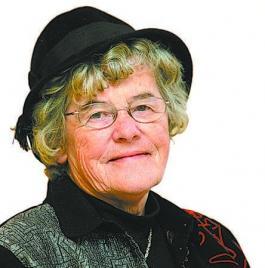
Ruby M. Cusack
“The First History of New Brunswick” by Peter Fisher
My head ached, my stomach hurt and even my teeth were aching but the lessons had to be studied for tomorrow’s test.
At this point, I really didn’t care when the Treaty of Utrecht was signed nor when New Brunswick ceased being a part of Nova Scotia nor that Grand Lake was the largest body of inland water in our province.
On the way home, I had fallen in the snow and some of it got into my book bag and melted, making my scribblers damp, which made the writing faded.
I had been in a hurry copying all those notes from the blackboard and now I couldn’t understand my writing.
It didn’t help that the adults were talking a mile a minute and no one offered to help poor me. I was really feeling sorry for myself.
Suddenly the room went silent and all eyes were on me as I felt the tears running down my cheeks.
I thought about telling them I had a pain in my stomach but that might be grounds to bring out the bottle of castor oil. I was quite surprised to hear myself saying, “I hate studying for this test as I can’t read my notes.” “Worst of all is the thought of writing out each wrong answer ten times after the test is marked and returned.”
To my surprise, Gramp pulled up a chair by the table, took my scribbler in his hand and read the notes to me. He even took time to explain the things that I didn’t understand.
I heard Gram jokingly tell Mum, she thought Gramp studied from “The First History of New Brunswick” that was compiled by Peter Fisher in 1825, who was considered to be New Brunswick’s first historian.
Gramp quickly retorted that if I had to prepare for a test from that book, I would need to know facts such as:
1) King James the First gave the first grant of land to Sir William Alexander in 1621.
2) In 1760, a number of persons from the County of Essex, Massachusetts, obtained a grant of a township, twelve miles square, on the River Saint John, from the British Government. After several delays in exploring and surveying, they commenced a settlement at Maugerville.
3) 1816 was the year when there was frost every month with a three to four inch snowfall on June 7.
4) The County of York is more than two hundred miles in length.
5) Upwards of ten thousand pounds of sugar was extracted from the maple syrup in one parish in Kings County.
If we listen, we can learn much from the words and writings of grandparents and the older generation as did the Rev. W. O. Raymond when he met with William Fisher, the youngest son of Peter Fisher in his apartment in the old Park Hotel in St. John. William’s sister had compiled a manuscript of her recollections of the various conversations with her elderly grandmother, Mary Fisher, concerning the coming of the Loyalists to New Brunswick and the experience of the family at St. Ann’s. Fortunately this was included in the revised edition of Peter Fisher’s publication.
I particularly enjoyed the information on food - how the pigeons were responsible for future crops of green beans - and of the finding of large patches of pure white beans marked with a black cross. The Loyalist settlers missed their tea so at times they steeped labrador, spruce or hemlock bark but did not find it to their liking. The first storekeeper at St. Ann’s, a man named Cairnes, sold tea at $2.00 per pound.
Spending time reading “The First History of New Brunswick” that was compiled by Peter Fisher, will give the genealogical researcher a much clearer understanding of the background of New Brunswick’s government, militia, settlers with their difficulties, boundaries, rivers, topographical description of the counties, and notes regarding the compiler.
Query 1896
Beavan - Shaw - Tabor: I am searching for information on James Vaughan Tabor who was living in Portland, St. John in the 1840s, son of Jesse Tabor and Mary Vaughan married Leah Seely Wilson 1837, died 1869 Woodstock.
Is he the same James Vaughan Tabor of Stetson, Maine, who was attending Harvard Medical School in 1866-67? I found a reference to him as a student and his instructor as FWC Beavan. I believe that my Great, Great Grandfather Dr Frederick Williams Cadwalleder Beavan could be his instructor, given the unusual initials. Some readers may be familiar with Frederick’s wife Emily Elizabeth Beavan nee Shaw who wrote many tales and poems for the Amaranth and the book “Sketches and tales illustrative of life in the backwoods of New Brunswick, North America: gleaned from actual observation and experience during a residence of seven years in that interesting colony” as Mrs F. Beavan, Emily B….. etc.
It is rather a curious thing as Dr Beavan, by this time, was well settled in Australia and passed away in 1867 but he often travelled to Portland and Boston in the 1840s when he was residing in New Brunswick. He had made trips back to England from Australia for further training etc in the 1850s so it is not unfeasible he also returned to Boston but, if so, why???
Contact Lynette Nunn, 45 Scott St., Deagon Qld, Australia 4017. Email genielynau@bigpond.com or genielynau@yahoo.com
***********************
If anyone is interested in purchasing a copy of “Sketches and tales illustrative of life in the backwoods of New Brunswick, North America: gleaned from actual observation and experience during a residence of seven years in that interesting colony” by
Emily Elizabeth Beavan nee Shaw visit http://www.rubycusack.com/Book-Beavan.html
|
New and Used Genealogical and Historical books of New Brunswick for sale. |
Back to Home of rubycusack dot com